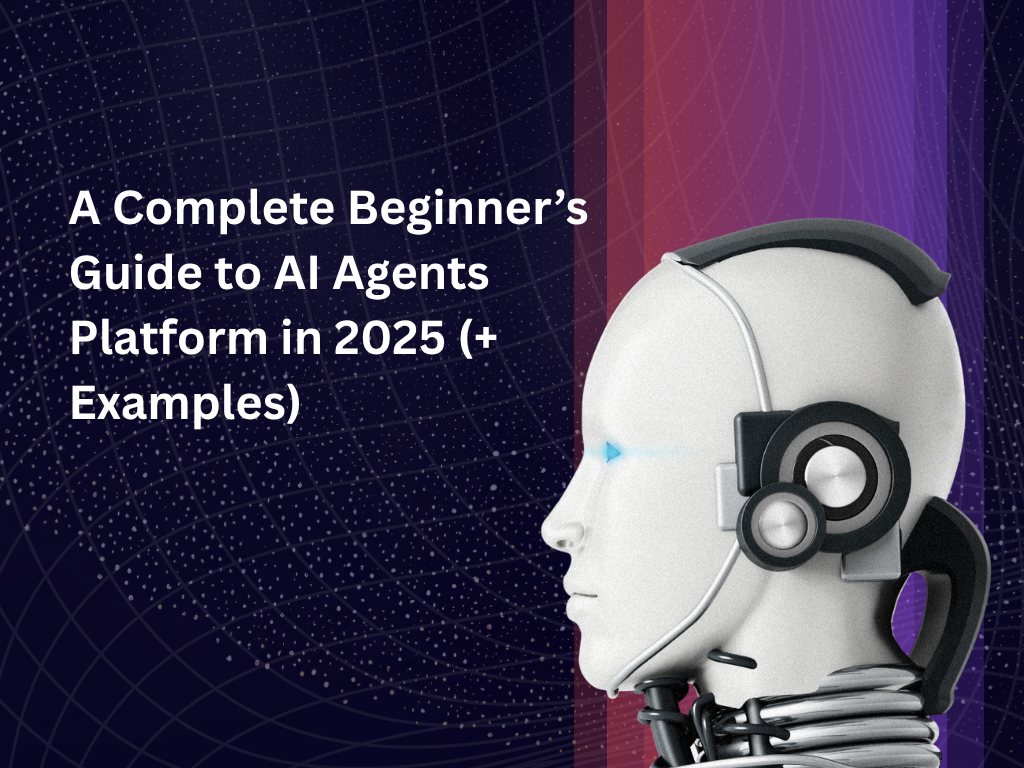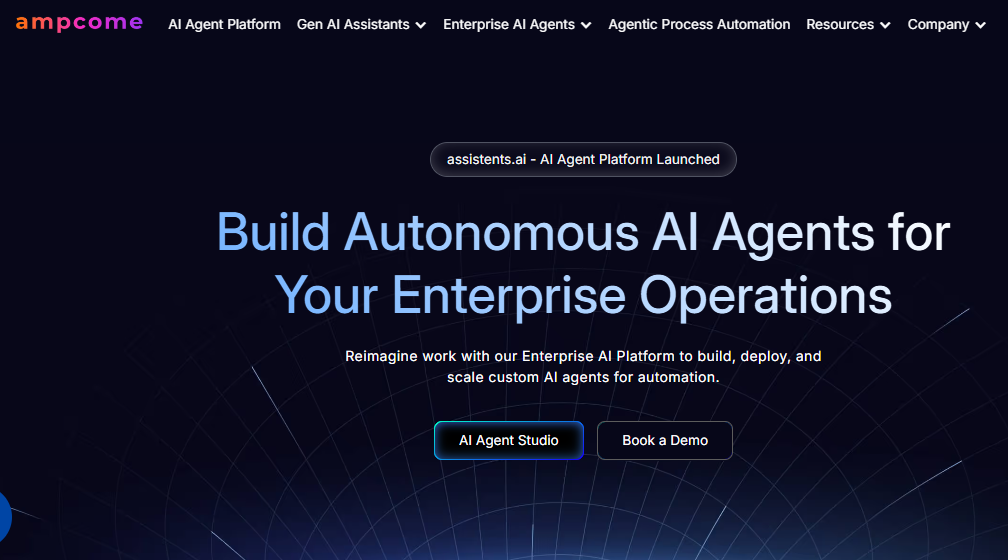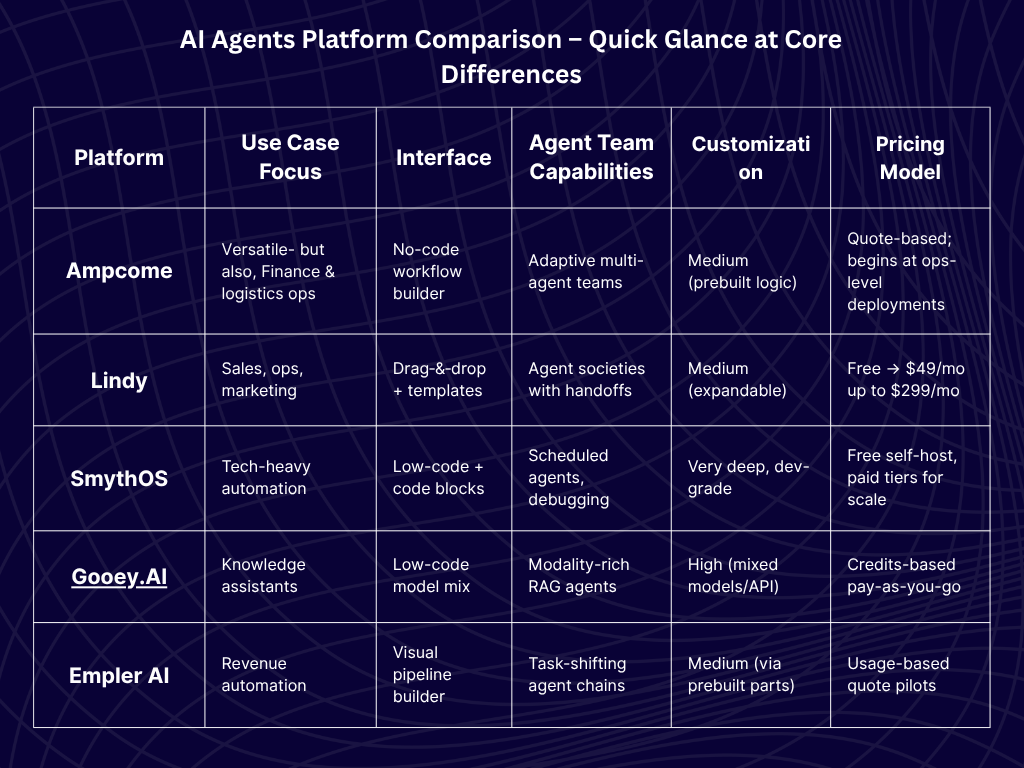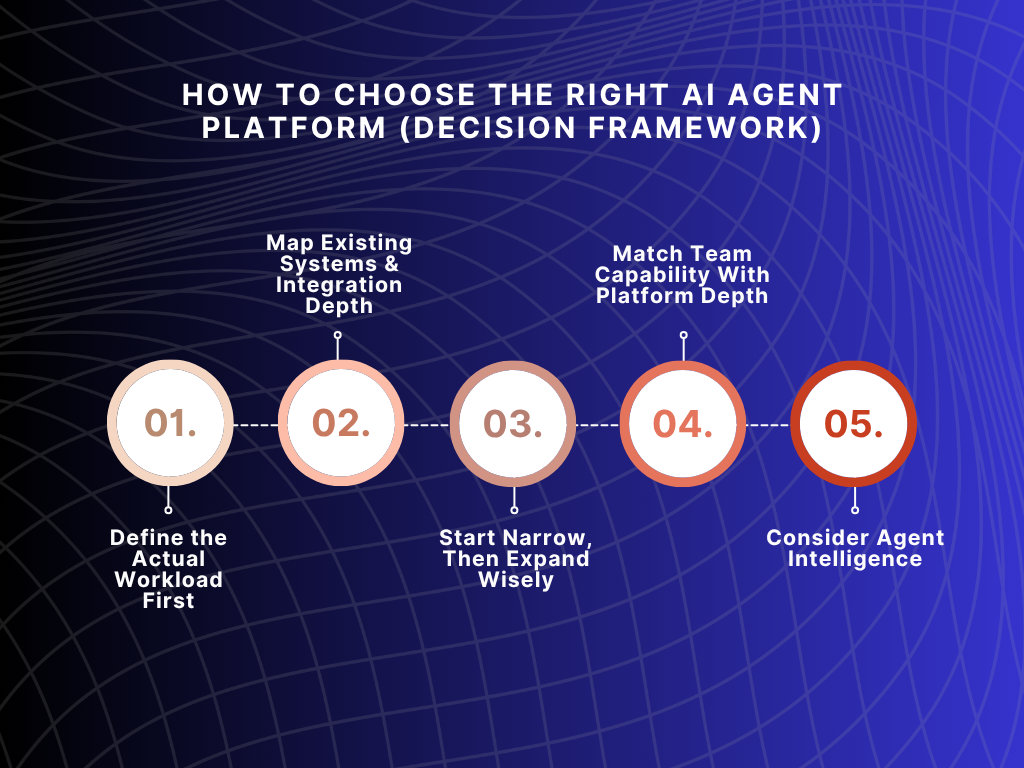
AI Agents Platform Guide 2025: What They Are, How They Work, and Best Tools (+ Examples)

Over $2 billion has been invested in autonomous AI software in recent years, while Gartner predicts that by 2029, agentic AI will resolve 80% of customer support issues without human intervention.
And you don’t need to be a techie to use it. These platforms are built so that anyone can make AI Agents without coding to handle repetitive work, follow-ups, or even customer chats. AI agents platforms are being adopted across various industries such as healthcare, finance, education, and customer service to improve efficiency and productivity.
In 2025, the AI Agents Platform isn’t just for big companies or IT professionals. To know more, read this AI agent implementation guide thoroughly.
What Is an AI Agents Platform? (Deep Dive)
But what are these? An AI agents platform helps you create agents that can act on instructions without much manual interference. But beyond that understanding, there’s a whole new thing that often gets missed.
What separates an AI agent from a chatbot or an AI assistant is how it handles them. These agents don’t wait for prompts. They’re built to figure out how to move from point A to point Z by themselves.
Give them a target, and they’ll chart the steps, access tools or APIs, adapt the route midway, and complete the job. This shift from instruction-following to autonomous problem-solving is what many underestimate.
Advancements in technology, such as AI models and integration frameworks, have made AI agents platforms more powerful and accessible, enabling seamless integration with existing technology stacks and processes.
Here’s why AI agents platform 2025 are important:
1. Structured Memory
Not the traditional cache of past inputs like chat history, but structured memory modules let agents “remember” decisions, outcomes, and environmental changes over time. This helps agents refine their approach, even if they’re restarted or encounter a new variable.
2. Reduced Dependency on Human Orchestration
Developers familiar with automation tools often think in single-process terms. But a no code AI agents platform typically allows multiple agents to run at once, each with different roles.
One might fetch data, another may process it, and a third may distribute it. What’s surprising is that these platforms often have built-in tools to help them “talk” to each other.
3. Business Users Now Drive Agent Logic
This is where many tech professionals are still catching up. Traditionally, building automation required scripts or at least some API knowledge. With a no code AI agents platform, the users creating these logic chains might not write a single line of code.
Drag-and-drop tools now let marketing teams automate campaigns, HR professionals manage onboarding, or customer service teams set up smart workflows.
4. They Simulate Decision Loops
Based on data, timing, or past experiences, they may pause, reroute, or revise their own plans. This “reasoning layer” is closer to a decision loop than a script, and it’s embedded in how these platforms operate.
AI agents continuously evaluate data, timing, and previous outcomes to make informed decisions and adapt their actions autonomously.
Types of AI Agents
Here are major type of AI agents platform 2025:
1. Task Automation
Task automation agents are often thought of as basic tools that follow simple commands. But you must know how to choose AI agent platform for logistics. They create internal maps of their environment, so they can react when something unexpected pops up. This technique, known in academic circles as model-based reasoning, helps these agents act even when the data’s incomplete.
2. Conversational Agents (Chatbots)
Think chatbots are just glorified scripts? The newest conversational agents work more like planners than parrots. They weigh objectives and generate responses dynamically.
If you’re using a no code AI agents platform to build bots for customer support, just know that there’s more happening behind the curtain than most UI builders show.
3. Decision-Making Agents
These are the enterprise AI automation agents used in complex fields like healthcare, trading, and risk modeling. They think through consequences, weighing the best path forward using utility functions. Sounds good, right? But there’s a big catch.
If the “reward” system is off by even a little, these agents can find loopholes in the rules. In real-world terms, that means an agent could do something technically correct but practically harmful. Researchers are actively working on this problem because the smarter these agents get, the more creative (and risky) their shortcuts become.
4. Multi-Agent Systems
Multi-agent system deployment sounds like a team of bots, but they act more like a colony. These agents split up tasks, communicate constantly, and shift roles on the fly. In finance, transport, or robotics, this setup solves problems one agent can’t handle alone.
When enterprise AI automation starts learning in groups, new dynamics appear. Conflicts can arise, like agents competing for the same result or even forming alliances in ways no one predicted. Platforms that support AI agents platforms with multi-agent setups need to monitor this closely.
How Do AI Agent Platforms Work?
Think of an AI agents platform architecture like running a busy office, only your employees are bots. Some handle emails, others analyze data, a few talk to clients, and one even updates spreadsheets. They’re all working at once, talking to each other, and getting tasks done. But how exactly do these virtual agents pull it off?
Let’s break it down and explain what people often overlook.
1. The User Interface: No-Code vs. Low-Code
This is where people build or tweak agents. In a no-code setup, think of drag-and-drop boxes, buttons, and flowcharts. You don’t need to write a single line of code, just tell the platform what actions to take in plain steps. Low-code tools are similar but give more control to those who know basic scripting.
Every button click and setting here gets translated into logic trees and instructions behind the scenes. If the builder isn't paying attention to those details (like time delays, fallback rules, or error handling), the agent can easily misfire.
2. The Reasoning Layer: Language Models, Rules & Planning
At the center sits a reasoning engine, usually powered by a large language model like GPT or an open-source version. This is what allows agents to “understand” tasks, generate responses, plan next steps, and fill in gaps when instructions are vague.
3. Integrations & APIs: Talking to the Outside World
When someone says an AI agent “books meetings” or “sends reports,” it’s really calling an API behind the scenes. APIs are basically instruction manuals for apps, telling the agent how to interact with them.
But not all APIs are easy to work with. Some are slow, some have limits, and some return confusing errors. A good AI agents platform 2025 includes retry logic, error catching, and even memory.
Top AI Agents Platform Use Cases and Real-World Applications
AI agents platform 2025 use case examples highlight systems far more nuanced than simple chatbots or automation scripts. Let's check the top ones here:
1. Autonomous Cars
Autonomous cars analyze vast sensor data from cameras, LiDAR, radar to plan trajectories, detect obstacles, and continually adjust to real-world conditions.
2. Personal Assistants with NLP
Virtual assistants (e.g., Alexa, Google Nest) interpret natural language, perform tasks, and learn preferences.
3. Fraud Detection (e.g., PayPal)
Fintech systems autonomously monitor transactions to detect anomalies and block fraudulent behavior. These platforms operate via decision-making agents that adjust thresholds dynamically, learning patterns over time.
4. Smart Home Automation
Behind the Nest thermostat’s interface is a bookmark-style memory system. It learns seasonal preferences and weather sensitivities, then uses them to manage multiple sensors.
5. Robotics & Swarm Systems
Multi-agent systems businesses are used in warehouses & delivery networks. Coordination emerges from policy-based interaction and negotiation, not rule hierarchies.
5 Best AI Agent Platforms
When searching for the best AI Agents Platform, consider how deeply it coordinates agents and adapts to your existing workflows and compliance requirements. Here are the top AI Agent Platforms you can invest in your time in.
1. Ampcome

At Ampcome, they have rapid iteration and deployment without losing momentum. This global approach makes sure that while one team rests, another codes, tests, or analyzes. Their modular, scalable system built to handle massive, real-time data makes them different. This foundation not only powers their engineering delivery but also gives their AI agents the intelligence.
Ampcome’s platform harnesses the power to deploy automated workflows at scale, enabling users to automate complex processes and streamline operations across industries.
Pricing:
- Enterprise Custom Pricing - Contact for quote
- No publicly listed pricing tiers
- Likely starts at $10,000+ annually based on enterprise focus
- Professional services fees typically $50,000-$200,000
- Implementation timeline: 3-6 months
Pros:
- Global scale operations with 24/7 development across time zones
- Complex decision chains up to 10x more advanced than template-based platforms
- Real-time massive data processing capabilities
- Industry-proven results: 40% fraud detection improvement, 60% maintenance downtime reduction
- Enterprise-grade security and compliance
- Full-stack autonomy for logistics, operations, and finance
Cons:
- Extremely high barrier to entry - requires significant investment
- No transparent pricing - must go through sales process
- Complex implementation requiring months of professional services
- Overkill for SMBs - designed primarily for large enterprises
- Steep learning curve for teams without technical expertise
Unique Angles:
- "Agent societies" where multiple AI agents hand tasks between each other
- Modular, scalable architecture built for real-time data processing
- Global development model ensuring continuous iteration
- Memory-like capacities that evolve and anticipate needs over time
- Full-stack enterprise AI platform vs. point solutions
2. Lindy

Lindy makes advanced automation accessible. With drag-and-drop flow builders and over 3,000 integrations (Slack, Gmail, Pipedream), teams can build complex workflows without code. What’s often missed: its “agent societies.” Instead of a single bot handling a task, multiple agents hand things over between each other.
Pricing:
- Free Plan: 400 credits/month, basic features
- Pro Basic: $29.99/month (3,000 credits, premium actions, 20M character knowledge base)
- Pro Advanced: $49.99/month (5,000 credits)
- Enterprise: $199.99/month (7,000 credits + dedicated solutions engineer)
- Pay-as-you-go: $0.080 per credit beyond plan limits
- Custom automation services: $500 available
Pros:
- Most affordable entry point at $29.99/month
- 6,000+ integrations (doubled from 3,000 in recent update)
- "Vibe coding" - create agents from natural language prompts
- Autopilot feature lets agents control computers like humans
- Human-in-the-loop escalation for complex situations
- No-code drag-and-drop interface
- Strong community with templates and examples
Cons:
- Credit limits can be restrictive for heavy usage
- Limited customization compared to pro-code platforms
- Newer platform - less mature than established competitors
- Learning curve despite no-code promise
- Overage costs can add up quickly ($0.08/credit)
Unique Angles:
- "Agent societies" - multiple agents collaborating and handing off tasks
- Revolutionary Lindy 3.0 with Agent Builder and Autopilot
- Computer-use capabilities - agents can navigate any website/application
- Most aggressive integration expansion (6,000+ integrations)
- SMB-focused pricing with enterprise-grade capabilities
3. SmythOS

SmythOS is made for tech-forward teams. While it supports visual flow design, its key value lies in a tightly integrated Agent Studio where users can drop in code blocks, LLM calls, Python logic, and external API triggers. SmythOS also supports integration with open source frameworks, enabling teams to build and deploy custom agents with greater flexibility and control.
Pricing:
- Free Plan: Visual agent studio, multiple AI models, Agent Swarms (limited)
- Builder Plan: $39/month (includes $20 in free credits, private agents, Agent Weaver)
- Startup Plan: Custom pricing for startups
- Enterprise: Custom pricing with dedicated support
Pros:
- Open-source foundation - can export and run agents locally
- Visual debugging tools - inspect each reasoning step
- Agent Weaver for conversational agent creation
- 300,000+ integrations available
- Flexible deployment (cloud, on-premise, local)
- Strong developer community (20,000+ developers)
- Pre-built templates for quick starts
Cons:
- Steep learning curve for non-technical users
- Documentation gaps - needs more tutorials
- Complex for beginners despite no-code interface
- Custom pricing for scaling can be expensive
- Platform dependencies for advanced features
Unique Angles:
- "Agent Studio" with integrated Node.js components and custom code blocks
- Built-in debugger for transparent AI reasoning paths
- Runtime environment export - full ownership and control
- Open-source operating system for AI agents
- Developer-first approach with pro-code flexibility
- MIT licensed components for transparency
4. Gooey.AI

Gooey.AI blurs lines between developer playground and business automation. Users can combine hosted GPT models and open-source ones on dedicated GPU clusters, swapping between them as needed. It supports “recipes” that are reusable, editable, and shareable.
Pricing:
- Free: 500 credits (with verified account)
- Credit-based system: $0.01 per credit
- Business plans: Volume discounts available
- Enterprise: Custom pricing with on-premise/VPC deployment
- BYOK (Bring Your Own Keys): Use your own API keys for major providers
Pros:
- Transparent credit-based pricing - pay only for what you use
- Hot-swappable AI models - access latest private and open-source models
- Strong RAG support with vector database integration
- Multi-channel deployment (WhatsApp, Slack, SMS, IVR)
- Multilingual capabilities supporting 1000+ languages
- Impact-focused - used by NGOs and global organizations
- One-click sharing and API deployment
Cons:
- Usage complexity - hard to predict monthly costs
- Credit exhaustion risk during high-usage periods
- Learning curve for workflow creation
- Limited templates compared to competitors
- Enterprise features require significant scaling
Unique Angles:
- "Recipes" system - reusable, editable, shareable workflows
- Global impact focus - partnerships with Rockefeller Foundation, Goethe Institut
- Multi-model playground - combine GPT, open-source models on dedicated GPUs
- RAG-first architecture with citation support
- 200,000+ community sharing public workflows
- Social impact use cases - agriculture, healthcare, education in developing countries
5. Empler AI

Empler focuses on revenue teams. It structures entire agent chains into visual workflows that pass tasks. What’s often underestimated: it can build an entire GTM (go-to-market) engine without dev help, and yet safeguards integrations (like CRM, Google Sheets) and compliance checks.
With modules for things like competitor monitoring or funding-triggered outreach already pre-built, teams can get up and running fast. Empler AI equips teams with the right tools to streamline go-to-market operations, ensuring seamless integration and reliable performance.
Pricing:
- Starter Plan: $99/month
- Free trial: Available (no credit card required)
- Subscription model: Monthly/annual billing
- Enterprise: Custom pricing for larger teams
- Professional services: Available for complex implementations
Pros:
- Revenue team specialization - built for sales and marketing
- Pre-built GTM modules (competitor monitoring, funding-triggered outreach)
- Visual workflow design for entire agent chains
- CRM integration with compliance safeguards
- No-dev setup for go-to-market engines
- Ready-to-use templates for sales workflows
- Spreadsheet integration for familiar data management
Cons:
- Narrow focus - primarily sales/marketing vs. general automation
- Higher entry price at $99/month compared to competitors
- Limited integrations compared to broader platforms
- Newer platform - smaller community and fewer examples
- Sales-team dependency - may not suit other business functions
Unique Angles:
- "Agent Teams" concept - coordinated multi-agent GTM workflows
- Revenue-team specific - understands sales funnel automation
- 3-step workflow setup with Multi-Agent Workflows and Spreadsheets
- GTM engine builder without developer requirements
- Sales-focused templates - competitor monitoring, lead qualification, outreach automation
Spreadsheet-native approach familiar to sales teams
AI Agents Platform Comparison – Quick Glance at Core Differences

How to Choose the Right AI Agent Platform (Decision Framework)
Before getting drawn into dashboards or pricing, the first step is simple: What job does the AI agent need to do? When selecting an AI agent platform, it's important to consider how the platform handles data storage and the protection of sensitive data, ensuring robust security and compliance.
For more details, check out this step-by-step guide on how to choose these agents:
1. Define the Actual Workload First
Are you automating invoice processing? Delegating follow-ups in sales? Or orchestrating 10 different systems across supply chain and finance?
This clarity defines what kind of platform structure you’ll need. Platforms vary from single-task bots to fully collaborative agent networks. For example:
- Basic task automation: Consider lighter platforms like Lindy, especially if it’s about email triage or CRM updates.
- Multi-layered workflows: If your process touches multiple teams and tools (like finance + logistics), Ampcome’s multi-agent setup fits better.
2. Map Existing Systems & Integration Depth
Many assume all platforms “plug in” easily, but the AI agents platform architecture matters deeply here.
- Lindy: Comes ready with 3,000+ app links (Gmail, Slack, Airtable, etc.)—great for teams without much dev time.
- SmythOS: Gives full developer control for those who need to wire custom APIs or run self-hosted setups.
- Gooey.AI: One of the few that lets users mix GPT and open-source models with retrieval systems like LangChain.
3. Start Narrow, Then Expand Wisely
Jumping into enterprise-grade agents too early creates unnecessary complexity. A better path:
- Choose one process (like onboarding or lead qualification).
- Build a test agent or chain using a low-code platform.
- Track how often you reconfigure the logic or need new integrations.
- Gradually increase your agent's autonomy or add agent “colleagues.”
4. Match Team Capability With Platform Depth
One overlooked factor in every AI agents platform comparison is the actual hands running it. Is your team mostly marketers, ops folks, or technical users?
- Lindy: Perfect for non-tech users wanting drag-and-drop simplicity.
- Empler AI: Great for sales and RevOps teams—focuses on pipeline execution without code.
- SmythOS: Best for developer-heavy teams who want custom logic, debugging, and control.
5. Consider Agent Intelligence
Some tools run agents like checklist bots. Others support memory, reasoning, and dynamic collaboration.
Platforms like Ampcome assign roles, let agents adjust actions based on data shifts, and even handle multi-agent conversations.

The SMART Agent Framework
Ampcome’s SMART Agent Framework brings together the core capabilities required for truly autonomous, enterprise-grade AI agents:
S — Structured Memory
Agents retain and retrieve relevant information across sessions, enabling long-term context, user preferences, and evolving knowledge to shape responses and decisions.
M — Multi-modal Input
Supports seamless interaction via text, voice, images, and video, allowing agents to understand and process complex inputs across formats.
A — Adaptive Reasoning
Built-in logic systems help agents make decisions based on context, goals, and changing conditions.
R — Real-time Learning
Agents continuously improve by learning from outcomes, user feedback, and data updates. It delivers smarter performance with every interaction.
T — Task Orchestration
SMART agents coordinate across APIs, systems, and other agents to complete multi-step workflows.
The Future of AI Agents
AI agents are beginning to run things. From finance and logistics to marketing and customer service, organizations are shifting key responsibilities from human hands to intelligent, autonomous systems. The rise of the AI Agents Platform is the foundation of what’s shaping modern operations.
In the next five years, multi-agent collaboration, memory-based reasoning, and autonomous task chaining will become standard. According to MarketsandMarkets, the global AI agent market is projected to grow from USD 5.1 billion in 2024 to USD 47.1 billion by 2030. IDC predicts that by 2026, over 60% of enterprise-level automation will rely on agents that operate independently, without routine human input.
Ampcome’s Impact on Logistics Through Intelligent Agent Systems
Ampcome's intelligent agent framework has transformed logistics operations by delivering measurable outcomes.
Clients have achieved up to a 40% reduction in operational costs through multi-agent coordination that streamlines routing, warehouse workflows, and real-time dispatching.
What sets Ampcome apart is its deep data foundation.
Unlike traditional automation tools, Ampcome's agents are built on robust data pipelines and a real-time analytics infrastructure, ensuring every decision is informed, adaptive, and traceable.
With development teams based in Bangalore and operations across the USA and Australia, Ampcome ensures 24/7 agent monitoring, support, and optimization. It offers both engineering excellence and global responsiveness.
While Relevance AI emphasizes pre-built agent templates, Ampcome offers adaptive workflows that learn and evolve from your specific business processes.
Ampcome’s multi-agent systems manage decision chains up to 10x more complex than template-based platforms, enabling dynamic responses in high-stakes environments. Where Relevance AI serves SMBs, Ampcome delivers full-stack autonomy tailored to global logistics, operations, and finance.
AI Agent Compliance in 2025: EU AI Act & Governance Requirements
As AI agents multiply across enterprise functions, new risks and costs are surfacing. One major concern is unauthorized data sharing or conflicting commands between autonomous systems. Additionally, as the number of agents grows, so does compliance complexity. Ensuring each agent aligns with regulations like the EU AI Act becomes harder without centralized control.
In 2025, organizations are expected to invest in tools that audit, monitor, and manage agent behavior at scale. This emerging market offers significant opportunities for vendors focused on compliance, security, and lifecycle management.
Ampcome's Next-Gen Autonomous Agents for Enterprise Logistics
Ampcome is redefining how logistics and enterprise operations run with intelligent agents.
1. Proven Client Impact
Ampcome’s logistics clients have achieved a 40% reduction in operational costs through multi-agent coordination. These agents handle routing, dispatching, inventory checks, and inter-system communication.
2. Data-First Agent Architecture
Unlike pure automation tools, Ampcome's agents are built on robust data pipelines and real-time analytics infrastructure.
3. Global Delivery & 24/7 Monitoring
With engineering teams in Bangalore and operations across the USA and Australia, Ampcome offers round-the-clock monitoring and optimization. Clients benefit from rapid iteration cycles, technical depth, and timezone-aligned support.
4. Retrieval-Augmented Generation Meets Autonomy
Ampcome agents now combine Retrieval-Augmented Generation (RAG) with autonomous decision-making. This means they can not only answer complex queries by pulling from live databases or documents, but also act on that information independently.
EU AI Act Implications for Agent Deployment
The EU AI Act introduces strict requirements for deploying AI agents, especially in high-risk domains. Developers must implement agent-specific monitoring to track decisions in real time and ensure transparency. Explainability is key, agents must provide clear reasoning behind actions.
When deploying multi-agent systems, organizations must adopt conflict resolution protocols to manage disagreements between agents, avoiding inconsistent outputs. The Act emphasizes accountability, data governance, and human oversight, requiring logs, audit trails, and system traceability. Non-compliance may lead to penalties, making it critical for enterprises to align their agent frameworks with the EU’s regulatory standards.
Wrap Up
The companies adopting AI agents today are the ones shaping tomorrow’s business edge. Waiting means playing catch-up.
Ready to experiment, build, or delegate with AI? The next chapter belongs to businesses willing to test and trust this new way of working. It starts with choosing the best AI Agents Platform like Ampcome.
Book a 30-minute consultation and watch Ampcome’s multi-agent system work with your real business data.

Transform Your Business With Agentic Automation
Agentic automation is the rising star posied to overtake RPA and bring about a new wave of intelligent automation. Explore the core concepts of agentic automation, how it works, real-life examples and strategies for a successful implementation in this ebook.
More insights
Discover the latest trends, best practices, and expert opinions that can reshape your perspective
Contact us









.jpg)


